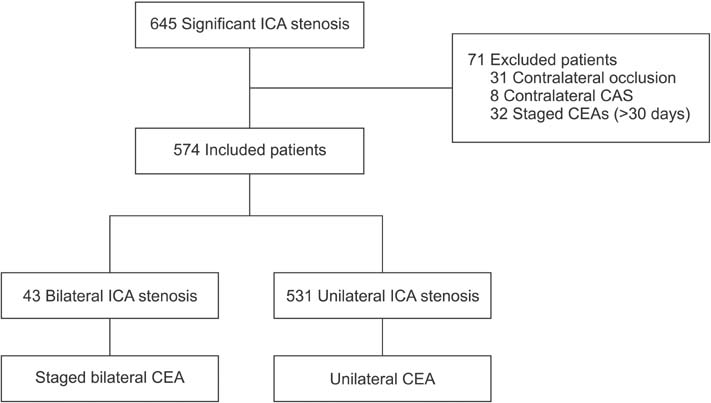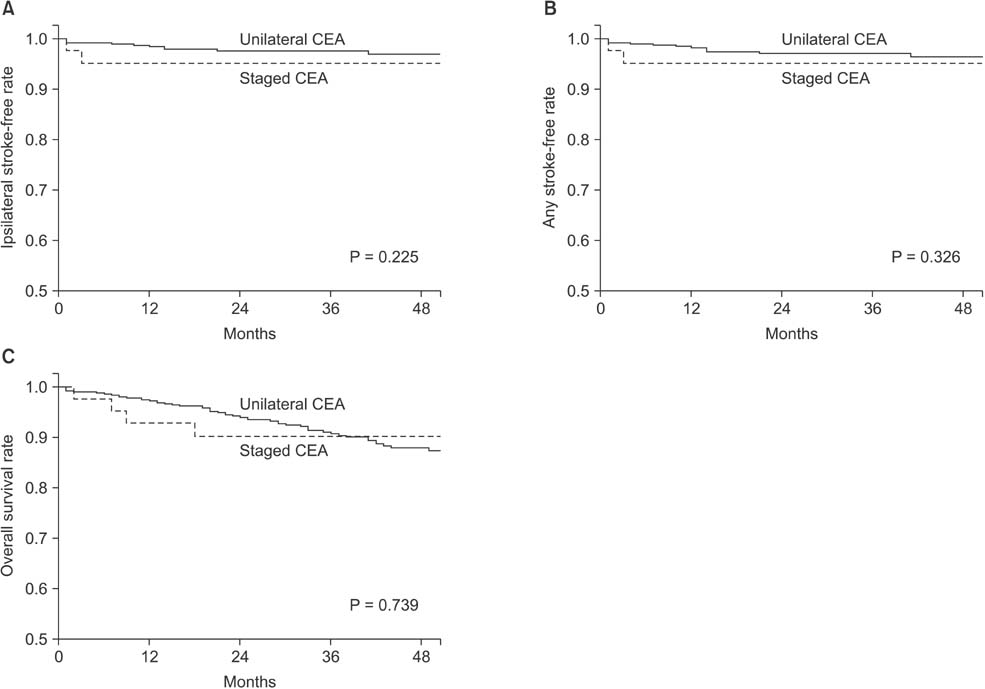Ann Surg Treat Res.
2015 Nov;89(5):261-267. 10.4174/astr.2015.89.5.261.
Clinical outcomes of staged bilateral carotid endarterectomy for bilateral carotid artery stenosis
- Affiliations
-
- 1Department of Surgery, Asan Medical Center, University of Ulsan College of Medicine, Seoul, Korea. ypcho@amc.seoul.kr
- 2Department of Neurology, Asan Medical Center, University of Ulsan College of Medicine, Seoul, Korea.
- KMID: 2095532
- DOI: http://doi.org/10.4174/astr.2015.89.5.261
Abstract
- PURPOSE
This retrospective cohort study aimed to determine the clinical outcomes of staged bilateral carotid endarterectomy (CEA) for bilateral internal carotid artery (ICA) stenosis performed with a short interval between the primary and secondary CEA procedures.
METHODS
In our institution, 574 consecutive patients underwent CEA between September 2007 and August 2014. Bilateral significant ICA stenosis was identified in 43 patients (7.5%) who underwent staged bilateral CEA within 30 days or less. Patients with unilateral CEA and staged bilateral CEA were compared in terms of CEA outcomes. The primary endpoint was the composite of any stroke, myocardial infarction, or death during the periprocedural period or ipsilateral stroke within 3 years after the CEA.
RESULTS
Staged bilateral CEA was not associated with ipsilateral stroke (P = 0.178) during postoperative follow-up. The two groups did not differ in terms of estimated 3-year primary endpoint rates (2.8% vs. 4.7%, P = 0.456) or ipsilateral stroke-free (P = 0.225), any stroke-free (P = 0.326), or overall (P = 0.739) survival rates.
CONCLUSION
Patients with bilateral significant ICA stenosis can undergo staged bilateral CEA within 30 days or less with outcomes that compare favorably with those of patients undergoing unilateral CEA.
MeSH Terms
Figure
Cited by 1 articles
-
Effect of severe contralateral carotid stenosis or occlusion on early and late outcomes after carotid endarterectomy
Min-Jae Jeong, Hyunwook Kwon, Min-Ju Kim, Youngjin Han, Tae-Won Kwon, Yong-Pil Cho
Ann Surg Treat Res. 2019;97(4):202-209. doi: 10.4174/astr.2019.97.4.202.
Reference
-
1. North American Symptomatic Carotid Endarterectomy Trial Collaborators. Beneficial effect of carotid endarterectomy in symptomatic patients with high-grade carotid stenosis. N Engl J Med. 1991; 325:445–453.2. European Carotid Surgery Trialists' Collaborative Group. MRC European Carotid Surgery Trial: interim results for symptomatic patients with severe (70-99%) or with mild (0-29%) carotid stenosis. Lancet. 1991; 337:1235–1243.3. Cunningham EJ, Bond R, Mehta Z, Mayberg MR, Warlow CP, Rothwell PM, et al. Long-term durability of carotid endarterectomy for symptomatic stenosis and risk factors for late postoperative stroke. Stroke. 2002; 33:2658–2663.4. Executive Committee for the Asymptomatic Carotid Atherosclerosis Study. Endarterectomy for asymptomatic carotid artery stenosis. JAMA. 1995; 273:1421–1428.5. Buratti L, Balucani C, Viticchi G, Falsetti L, Altamura C, Avitabile E, et al. Cognitive deterioration in bilateral asymptomatic severe carotid stenosis. Stroke. 2014; 45:2072–2077.6. Balucani C, Viticchi G, Falsetti L, Silvestrini M. Cerebral hemodynamics and cognitive performance in bilateral asymptomatic carotid stenosis. Neurology. 2012; 79:1788–1795.7. Diehm N, Katzen BT, Iyer SS, White CJ, Hopkins LN, Kelley L, et al. Staged bilateral carotid stenting, an effective strategy in high-risk patients -insights from a prospective multicenter trial. J Vasc Surg. 2008; 47:1227–1234.8. Brott TG, Halperin JL, Abbara S, Bacharach JM, Barr JD, Bush RL, et al. 2011 ASA/ACCF/AHA/AANN/AANS/ACR/ASNR/CNS/SAIP/SCAI/SIR/SNIS/SVM/SVS guideline on the management of patients with extracranial carotid and vertebral artery disease. Stroke. 2011; 42:e464–e540.9. Kim JH, Cho YP, Kwon TW, Kim H, Kim GE. Ten-year comparative analysis of bovine pericardium and autogenous vein for patch angioplasty in patients undergoing carotid endarterectomy. Ann Vasc Surg. 2012; 26:353–358.10. Marrocco-Trischitta MM, Melissano G, Kahlberg A, Setacci F, Abeni D, Chiesa R. Increased incidence of cerebral clamping ischemia during early contralateral carotid endarterectomy. J Vasc Surg. 2006; 43:1155–1161.11. Brott T, Adams HP Jr, Olinger CP, Marler JR, Barsan WG, Biller J, et al. Measurements of acute cerebral infarction: a clinical examination scale. Stroke. 1989; 20:864–870.12. Brott TG, Hobson RW 2nd, Howard G, Roubin GS, Clark WM, Brooks W, et al. Stenting versus endarterectomy for treatment of carotid-artery stenosis. N Engl J Med. 2010; 363:11–23.13. Farsak B, Oc M, Boke E. Simultaneous bilateral carotid endarterectomy: our first experience. Ann Thorac Cardiovasc Surg. 2001; 7:292–296.14. Rodriguez-Lopez JA, Diethrich EB, Olsen DM. Postoperative morbidity of closely staged bilateral carotid endarterectomies: an intersurgical interval of 4 days or less. Ann Vasc Surg. 2001; 15:457–464.15. Darling RC 3rd, Kubaska S, Shah DM, Paty PS, Chang BB, Lloyd WE, et al. Bilateral carotid endarterectomy during the same hospital admission. Cardiovasc Surg. 1996; 4:759–762.16. Roffi M, Yadav JS. Carotid stenting. Circulation. 2006; 114:e1–e4.17. Yadav JS, Wholey MH, Kuntz RE, Fayad P, Katzen BT, Mishkel GJ, et al. Protected carotid-artery stenting versus endarterectomy in high-risk patients. N Engl J Med. 2004; 351:1493–1501.18. White CJ, Iyer SS, Hopkins LN, Katzen BT, Russell ME. BEACH Trial Investigators. Carotid stenting with distal protection in high surgical risk patients: the BEACH trial 30 day results. Catheter Cardiovasc Interv. 2006; 67:503–512.19. Yun WS, Kwun WH, Suh BY. The early and mid-term results of carotid artery stenting in high-risk patients. J Korean Surg Soc. 2011; 80:283–288.20. Kakisis JD, Avgerinos ED, Antonopoulos CN, Giannakopoulos TG, Moulakakis K, Liapis CD. The European Society for Vascular Surgery guidelines for carotid intervention: an updated independent assessment and literature review. Eur J Vasc Endovasc Surg. 2012; 44:238–243.21. Henry M, Gopalakrishnan L, Rajagopal S, Rath PC, Henry I, Hugel M. Bilateral carotid angioplasty and stenting. Catheter Cardiovasc Interv. 2005; 64:275–282.22. Ziaja D, Biolik G, Kocelak P, Sznapka M, Janas P, Czajka A, et al. Neurological symptoms associated with cerebral hyperperfusion syndrome after CEA and CAS--one centre study. Eur Rev Med Pharmacol Sci. 2014; 18:1176–1180.23. Buczek J, Karlinski M, Kobayashi A, Bialek P, Czlonkowska A. Hyperperfusion syndrome after carotid endarterectomy and carotid stenting. Cerebrovasc Dis. 2013; 35:531–537.24. Yoshimoto T, Shirasaka T, Yoshidumi T, Fujimoto S, Kaneko S, Kashiwaba T. Stepwise revascularization for prevention of postoperative hyperperfusion. Neurol Med Chir (Tokyo). 2006; 46:283–287.
- Full Text Links
- Actions
-
Cited
- CITED
-
- Close
- Share
- Similar articles
-
- Carotid Endarterectomy in Bilateral Carotid Stenosis: Case Report
- Multiple Carotid Artery Occlusive Diseases Treated with Staged Subclavian-carotid Artery bypass and Carotid Endarterectomy: Case Report
- Recurrent Carotid Artery Stenosis
- Microsurgical Endarterectomy for Symptomatic Carotid Artery Stenosis
- Carotid Artery Stenting



